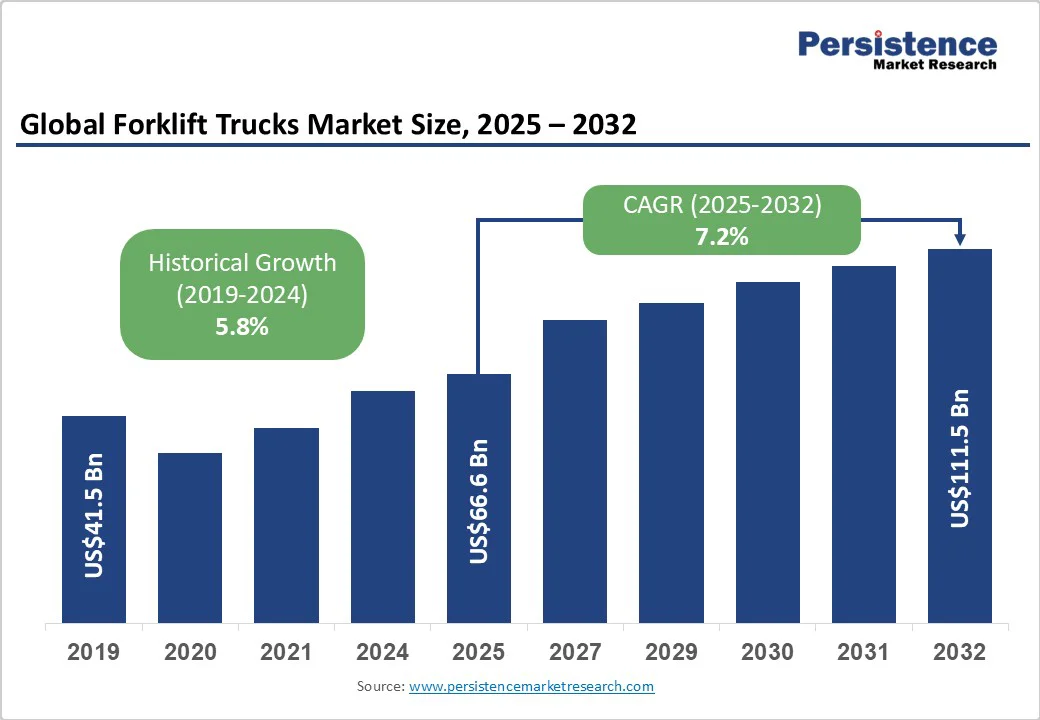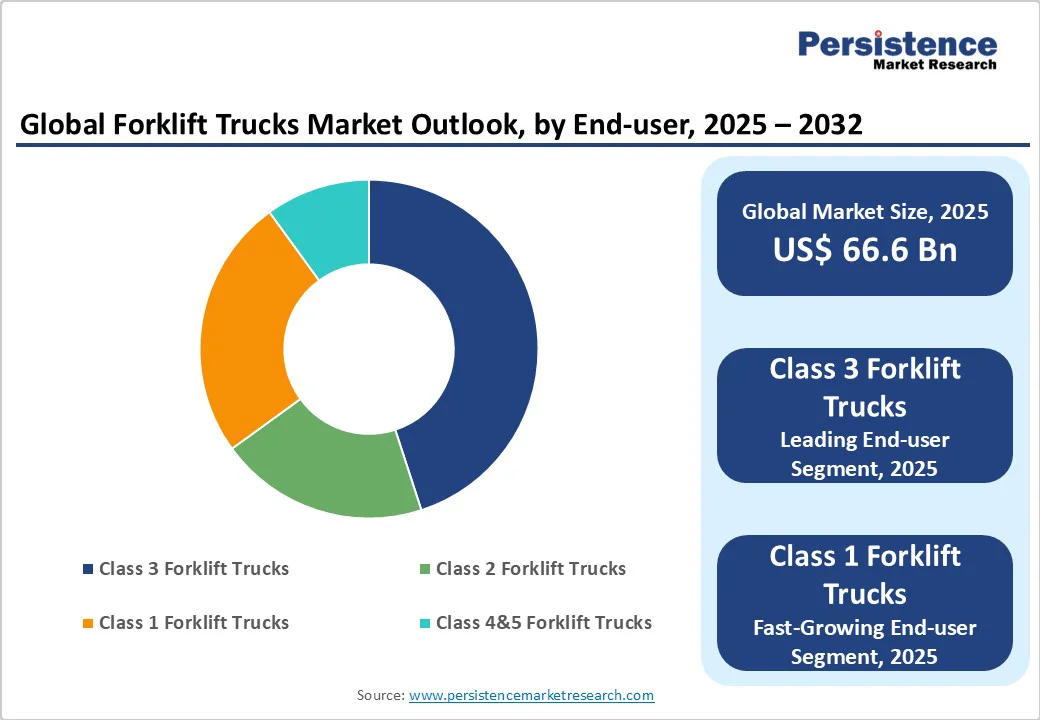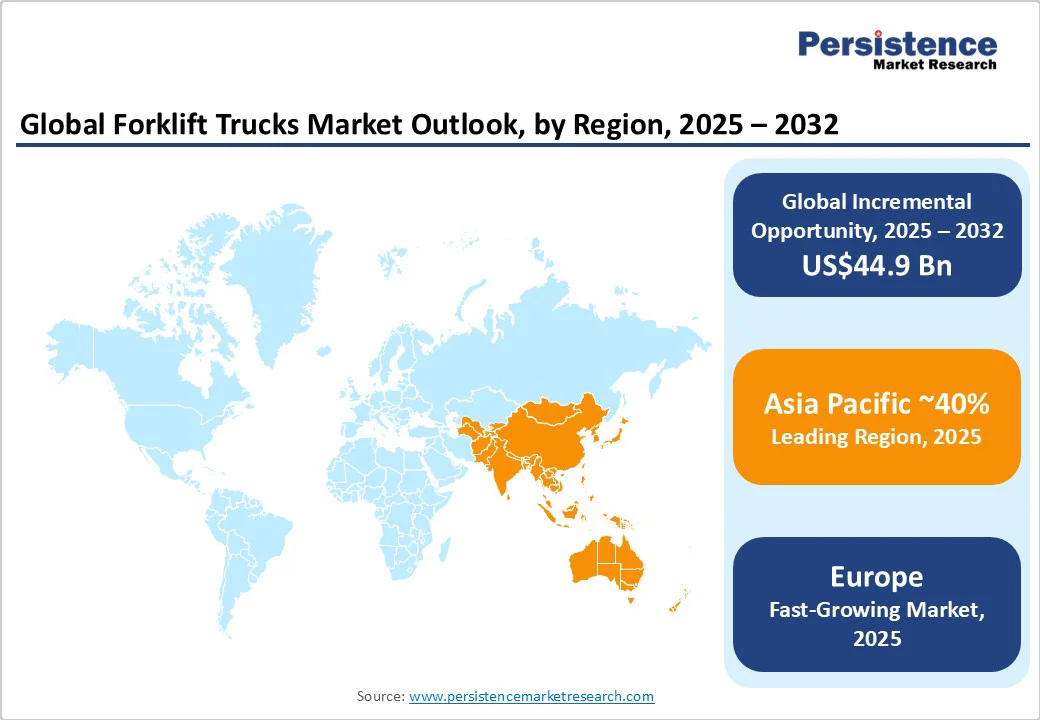ID: PMRREP3552| 200 Pages | 26 Sep 2025 | Format: PDF, Excel, PPT* | Automotive & Transportation

The global forklift trucks market size is expected to be valued at US$66.6 Bn in 2025. It is projected to reach US$111.5 Bn by 2032, growing at a CAGR of 7.2% from 2025 to 2032, driven by the expansion of e-commerce, supportive government initiatives, and rising sales volumes. Increasing disposable incomes, convenience, and shifting shopping behaviors are driving demand for compact trucks.
| Key Insights | Details |
|---|---|
| Forklift Trucks Market Size (2025E) | US$66.6 Bn |
| Market Value Forecast (2032F) | US$111.5 Bn |
| Projected Growth (CAGR 2025 to 2032) | 7.2% |
| Historical Market Growth (CAGR 2019 to 2024) | 5.8% |

Growing disposable income, convenient delivery options, impulsive shopping habits, and declining product costs are driving a surge in demand for material handling solutions. With the rise of e-commerce and increased online shopping, there has been a noticeable uptick in the number of individual item orders processed in warehouses.
For example, the U.S. Census Bureau, part of the Department of Commerce, has projected that total e-commerce sales in the U.S. for 2023 will reach approximately US$1.12 trillion, representing a 7.6% year-over-year growth. As sales volumes increase, warehouse aisles are becoming narrower, heightening demand for compact forklift trucks.
Forklifts that can quickly pick up and unload items are essential for effectively managing inventory in warehouses. To meet customer delivery expectations, many warehouses have implemented third shifts to ensure timely order dispatch.
For instance, in March 2024, Jungheinrich AG introduced a new series of forklift trucks named EJC 1i, specifically designed for warehouse and distribution center operations. Lithium-ion batteries power these forklifts and are available in five different capacities: 50 Ah, 100 Ah, 105 Ah, 150 Ah, and 200 Ah.
Forklift trucks can struggle to perform effectively in high-demand or damp environments, posing a challenge to market growth. In multi-shift operations, maintaining and charging batteries can be difficult. Additionally, the initial investment for these trucks is considerable, and the existing electrical supply must meet the voltage requirements for battery chargers.
Safety measures, such as proper flooring and eyewash stations, add to the costs. Internal combustion engine forklifts may not be suitable for indoor use without costly emission controls and adequate ventilation. Additionally, storing gasoline may require a bulk tank, depending on regional regulations. Fuel prices are expected to rise in the coming years.
The logistics and transport industries are significant contributors to carbon emissions, largely due to the reliance on conventional engines in industrial trucks and construction equipment. In response, various government agencies have implemented regulations aimed at lowering carbon footprints across regions.
Manufacturers are also adjusting their product shipments to adhere to updated standards and policies. For example, in March 2023, Toyota Industries Corporation announced that it would suspend production of two diesel forklift models and one gasoline forklift model. In regions such as the EU and California, buyers and rental agencies are aligning with emissions regulations, including the EU Stage V standards and California Air Resources Board (CARB) rules.
Rising disposable incomes, shifting consumer lifestyles, and competitive product pricing are fueling forklift truck demand in developing nations such as India. The growth of industrial warehouses, largely driven by third-party logistics providers, is transforming logistics networks and creating substantial demand for efficient material handling. Expanding skilled labor pools, technological innovation, and the adoption of green solutions across regions further accelerate this trend.
Manufacturers are also introducing hybrid lift trucks powered by both fuel-cell systems and lithium-ion batteries to reduce their environmental impact. Lithium-ion lift trucks, offering zero CO2 emissions, superior durability, and strong environmental performance, are gaining traction. For example, Toyota Material Handling Japan launched fuel cell lift trucks in September 2022 with 30% lower costs and improved durability.
Advancements in lithium-ion batteries are creating significant market opportunities, driven by their high energy density, electrical efficiency, and enhanced operator safety, all of which lower the overall cost of ownership for customers. There is a growing demand for on-board charging systems in warehouses and rental fleets, as they help improve operational efficiency.
The rising need for productivity, combined with a shortage of skilled labor, is driving the development of Automated Guided Vehicles (AGVs) and battery-powered forklifts. Companies are focusing on various battery charging solutions, like on-board, off-board, and hybrid options, to boost efficiency. However, many manufacturers are offering in-house charging solutions that provide cost-effective options, further propelling growth in the forklift market.
The counterbalance forklift trucks segment dominated the market in 2025, capturing a 52.2% share. These forklifts are preferred over warehouse-specific models because of their superior convenience and efficiency in handling heavy loads. Designed with a rear counterweight, they balance the load on the forks, ensuring greater stability, operational safety, and driver confidence. This simple yet robust design enables them to perform effectively across a wide range of material-handling applications across various industries.
Widely used in manufacturing plants, retail distribution centers, and logistics hubs, counterbalance forklifts have become indispensable for supporting the growth of industrial and commercial activities. Their adaptability to both indoor and outdoor environments further enhances their appeal.
As global logistics and supply chain networks expand and technological innovations in automation and power systems continue, the counterbalance forklift segment is projected to sustain strong demand and deliver profitable growth in the years to come.
In 2025, the Class 3 segment dominated the forklift trucks market, accounting for 44.2% of the market share. This category includes electric motorized hand trucks, which are hand-controlled forklifts operated with a tiller at the front or a handle at the back. Designed primarily for low-lift applications, these forklifts are widely used in warehouses to move goods efficiently across the floor without the need for high shelving or racks, making them an essential tool for everyday material handling tasks.
Meanwhile, the Class 1 segment is projected to grow at a significant CAGR during the forecast period. The rising demand for electric rider trucks across industries such as retail, food services, chemicals, and manufacturing is driving this growth. These forklifts, with fewer moving parts, reduce maintenance costs, improve maneuverability, and operate more quietly, making them particularly suitable for space-constrained and noise-sensitive environments.

Asia Pacific is projected to dominate the forklift trucks market in 2025, holding a 40% share. The region is home to leading manufacturers such as Doosan Corporation and Hangcha Forklift, which are driving technological innovation and intensifying market competition. The introduction of advanced electric forklift models with higher efficiency and performance is encouraging end-use industries to modernize their fleets for improved productivity.
China accounted for a significant share in 2025, driven by rapid industrial growth, favorable government policies that promoted smart manufacturing, and the booming e-commerce sector. The nation’s sustainability goals and carbon neutrality commitments are accelerating the transition from internal combustion engine (ICE) forklifts to electric and hydrogen-powered alternatives.
Japan also captured a notable share, with the market adapting to an aging workforce and rising automation needs in logistics and manufacturing. Companies are increasingly adopting robotic and AI-integrated forklifts, alongside a growing preference for sustainable, electric-powered models.
Europe is projected to experience steady growth in the forklift trucks market over the forecast period, supported by its robust automotive sector, rising investments in manufacturing facilities, and expanding logistics operations. The region is strengthened by the strong presence of leading players, including Toyota Material Handling, Jungheinrich AG, KION Group AG, Hyster-Yale Materials Handling, Inc., and Crown Equipment Corporation. These companies are actively pursuing product launches and business expansions to enhance market competitiveness.
For instance, in January 2023, KION Group announced an investment of approximately USD 11.9 million to develop and produce in-house fuel cell systems for industrial trucks, with plans to launch a 24V fuel cell system by spring 2023.
The German forklift market is evolving rapidly due to its strong industrial foundation, strict environmental regulations, and focus on automation. Sustainability initiatives and the European Union’s carbon reduction goals are accelerating demand for electric and eco-friendly forklift solutions.

The global forklift trucks market is experiencing impressive growth, highlighting its vibrant and evolving nature. To take advantage of this promising trend, companies in the industry are rolling out innovative products and using cutting-edge technologies to create new opportunities.
Key players are implementing essential strategies, such as diversifying their product offerings, expanding their reach into different regions, and investing in research and development. By focusing on these initiatives, businesses aim to remain competitive, adapt to changing consumer needs, and propel further growth. This proactive approach is shaping a dynamic future for the market.
The forklift trucks market is estimated to be valued at US$66.6 Bn in 2025.
The key demand driver for the forklift trucks market is the rapid growth of e-commerce and warehousing activities, coupled with increasing industrialization and manufacturing expansion.
In 2025, the Asia Pacific region is expected to dominate the market with a revenue share exceeding 45%.
Among the product types, counterbalance forklift trucks are anticipated to hold the highest share, capturing beyond 52.2% of the market revenue share in 2025.
The key players in the Forklift Trucks market are Sumitomo Heavy Industries, Ltd, Toyota Material Handling, BYD, Manitou Group, and Kalmar (Cargotec Finland Oy).
Forklift Trucks Market research, Forklift Trucks Market industry, Forklift Trucks Market trends, Global Forklift Trucks Market, Forklift Trucks Market size, Forklift Trucks Market forecast, Forklift Trucks Market analysis, Forklift Trucks Market report, Forklift Trucks Market trends and insights
| Report Attribute | Details |
|---|---|
| Historical Data/Actuals | 2019 - 2024 |
| Forecast Period | 2025 - 2032 |
| Market Analysis | Value: US$ Bn |
| Geographical Coverage |
|
| Segmental Coverage |
|
| Competitive Analysis |
|
| Report Highlights |
|
By Product Type
By End-user
By Class
By Technology
By Region
Delivery Timelines
For more information on this report and its delivery timelines please get in touch with our sales team.
About Author